Integrated Geophysical Techniques to Investigate Water Resources in Self-Sustained Carbon-Farming Agroforestry
Abstract
1. Introduction
2. Geological Setting
3. Methodology
3.1. Remote Sensing Techniques
3.2. Geophysical Investigation
3.2.1. Electrical Resistivity Tomography (ERT)
3.2.2. Seismic Refraction Tomography (SRT)
3.2.3. Ground Penetrating Radar (GPR)
3.2.4. Very Low Frequency Method (VLF)
4. Results and Discussion
4.1. Remote Sensing
4.2. Integrated Surface Geophysical Investigation
4.2.1. ERT Results
4.2.2. SRT Results
4.2.3. GPR Results
4.2.4. VLF Results
4.2.5. Integrated Geophysical Interpretation
5. Conclusions
Author Contributions
Funding
Data Availability Statement
Acknowledgments
Conflicts of Interest
Appendix A
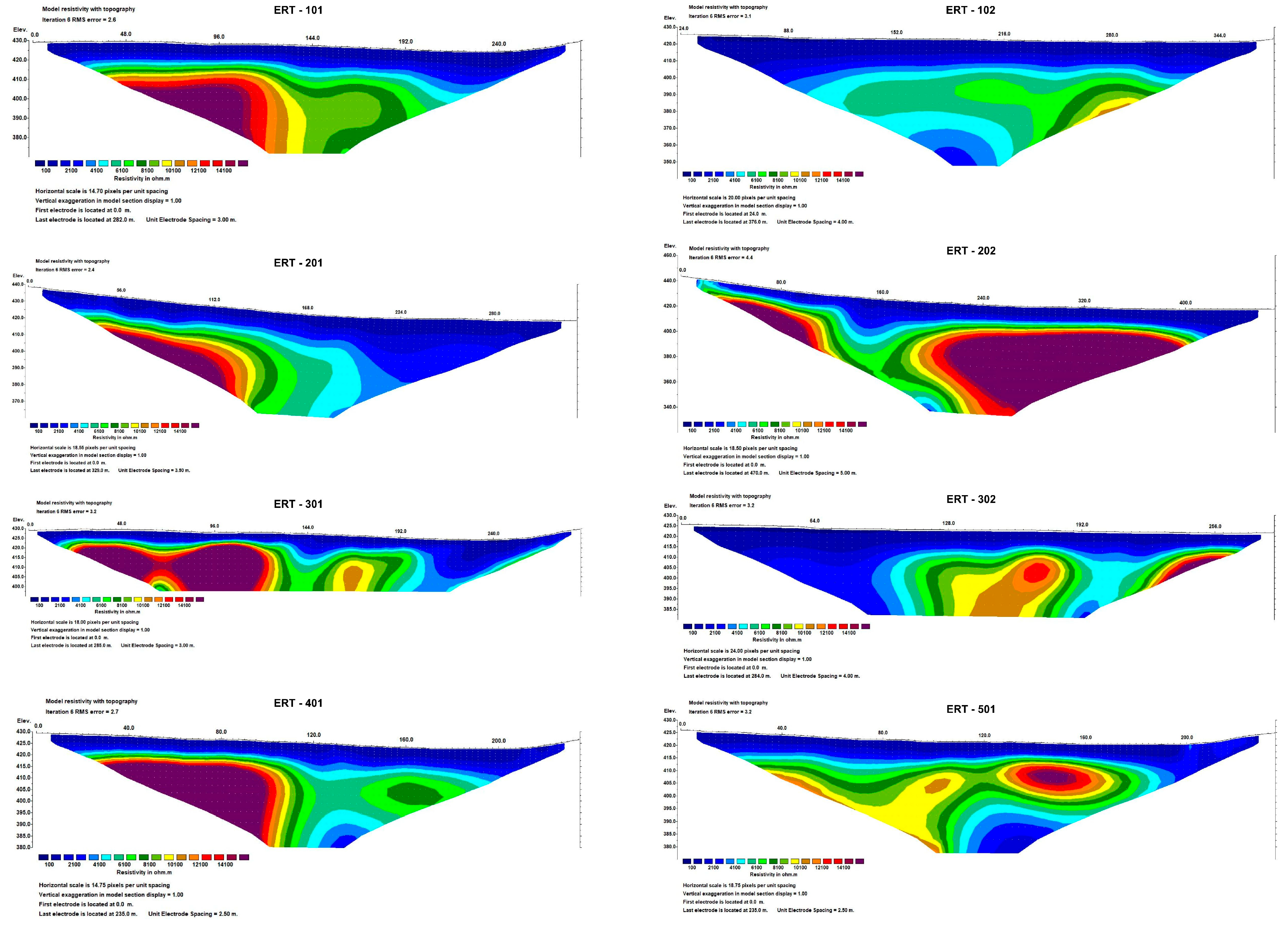
References
- Begizew, G. Agricultural production system in arid and semi-arid regions. Int. J. Agric. Sci. Food Technol. 2021, 7, 234–244. [Google Scholar] [CrossRef]
- Heyns, P. Water conservation in arid and semi-arid regions. In Water Resources Management; Savenijie, H.H.G., Hoekstra, A.Y., Eds.; EOLSS Publications: Oxford, UK, 2009; Volume I, pp. 113–149. [Google Scholar]
- Conti, N.; Scatena, L.; Lombardi, E.; Roscani, V.; Meconcelli, E.; Franciamore, F.; Valdeolmillos, D.; Marra, E.; Manzini, J.; Paris, P.; et al. Living Hubs in the INNO4CFIs Project. From Ground to Satellites to AI Applications: Integrating Advanced Technologies for Carbon Farming in Agroforestry. In Distributed Computing and Artificial Intelligence, Special Sessions I, 21st International Conference; Springer Nature: Cham, Switzerland, 2025; Volume 1198, p. 399. [Google Scholar] [CrossRef]
- Giannopoulos, I.K.; Alexopoulos, J.D.; Dilalos, S.; Gkosios, V.; Mitsika, G.S.; Stamatakis, M.; Voulgaris, N. The geophysical identification of lateritic bauxite formation at Mandra area, Attiki (Greece). Bulletin of the Geological Society of Greece, Special Publication No 10, GSG2022-026. In Proceedings of the 16th International Congress of the Geological Society of Greece, Patras, Greece, 17–19 October 2022. [Google Scholar]
- Alexopoulos, J.D.; Dilalos, S.; Voulgaris, N.; Gkosios, V.; Giannopoulos, I.K.; Kapetanidis, V.; Kaviris, G. The contribution of near-surface geophysics for the site characterization of seismological stations. Appl. Sci. 2023, 13, 4932. [Google Scholar] [CrossRef]
- Allred, B.J.; Freeland, R.S.; Farahani, H.J.; Collins, M.E. Agricultural geophysics: Past, present, and future. In Proceedings of the 23rd EEGS Symposium on the Application of Geophysics to Engineering and Environmental Problems, Keystone, CO, Canada, 11–15 April 2010; European Association of Geoscientists & Engineers: Utrecht, The Netherlands, 2010; p. cp-175-00023. [Google Scholar] [CrossRef]
- Liu, X.; Dong, X.; Leskovar, D.I. Ground penetrating radar for underground sensing in agriculture: A review. Int. Agrophys. 2016, 30, 533–543. [Google Scholar] [CrossRef]
- Mitsika, G.S.; Alexopoulos, J.D.; Vassilakis, E.; Dilalos, S.; Poulos, S.E. Investigation of the physical-geographical characteristics of river delta with geophysical and satellite data. The case study of Pineios River, Greece. MethodsX 2023, 10, 102033. [Google Scholar] [CrossRef] [PubMed]
- Mastrocicco, M.; Vignoli, G.; Colombani, N.; Zeid, N.A. Surface electrical resistivity tomography and hydrogeological characterization to constrain groundwater flow modeling in an agricultural field site near Ferrara (Italy). Environ. Earth Sci. 2010, 61, 311–322. [Google Scholar] [CrossRef]
- Olufemi, F.O.; Akinola, B.E.; Oladipupo, B.A. Geophysical Survey for Groundwater Resource Appraissal in a Basement Complex Terrain for Agricultural Purposes; Case Study of ABUAD Teaching and Research Farm, Ado Ekiti, Southwest Nigeria. Glob. J. Sci. Front. Res. H Environ. Earth Sci. 2014, 14, 1–14. Available online: http://eprints.abuad.edu.ng/id/eprint/3 (accessed on 8 March 2019).
- Pathirana, S.; Lambot, S.; Krishnapillai, M.; Cheema, M.; Smeaton, C.; Galagedara, L. Ground-penetrating radar and electromagnetic induction: Challenges and opportunities in agriculture. Remote Sens. 2023, 15, 2932. [Google Scholar] [CrossRef]
- Billi, A.; De Filippis, L.; Poncia, P.P.; Sella, P.; Faccenna, C. Hidden Sinkholes and Karst Cavities in the Travertine Plateau of a Highly-Populated Geothermal Seismic Territory (Tivoli, Central Italy). Geomorphology 2016, 255, 63–80. [Google Scholar] [CrossRef]
- Cueto, M.; Olona, J.; Fernández-Viejo, G.; Pando, L.; López-Fernández, C. Karst-Induced Sinkhole Detection Using an Integrated Geophysical Survey: A Case Study along the Riyadh Metro Line 3 (Saudi Arabia). Near Surf. Geophys. 2018, 16, 270–281. [Google Scholar] [CrossRef]
- Chávez, R.E.; Tejero-Andrade, A.; Cifuentes, G.; Argote-Espino, D.L.; Hernández-Quintero, E. Karst Detection beneath the Pyramid of El Castillo, Chichen Itza, Mexico, by Non-Invasive ERT-3D Methods. Sci. Rep. 2018, 8, 15391. [Google Scholar] [CrossRef]
- Prins, C.; Kurosch, T.; Krautblatter, M.; Schulz, R. Testing the Effectiveness of an Inverse Wenner-Schlumberger Array for Geoelectrical Karst Void Reconnaissance, on the Swabian Alb High Plain, New Line Wendlingen–Ulm, Southwestern Germany. Eng. Geol. 2018, 249, 71–76. [Google Scholar] [CrossRef]
- Giannopoulos, I.K.; Alexopoulos, J.D.; Mitsika, G.S.; Konsolaki, A.; Dilalos, S.; Vassilakis, E.; Voulgaris, N. A preliminary geophysical investigation regarding the possible extension of Alistrati cave in Serres Greece. In Proceedings of the NSG2023 29th European Meeting of Environmental and Engineering Geophysics, Edinburgh, UK, 3–7 September 2023; European Association of Geoscientists & Engineers: Utrecht, The Netherlands, 2023; Volume 1, pp. 1–5. [Google Scholar] [CrossRef]
- Bermejo, L.; Ortega, A.I.; Guérin, R.; Benito-Calvo, A.; Pérez-González, A.; Parés, J.M.; Aracil, E.; Bermúdez de Castro, J.M.; Carbonell, E. 2D and 3D ERT Imaging for Identifying Karst Morphologies in the Archaeological Sites of Gran Dolina and Galería Complex (Sierra de Atapuerca, Burgos, Spain). Quat. Int. 2017, 433, 393–401. [Google Scholar] [CrossRef]
- Cheng, Q.; Tao, M.; Chen, X.; Binley, A. Evaluation of Electrical Resistivity Tomography (ERT) for Mapping the Soil–Rock Interface in Karstic Environments. Environ. Earth Sci. 2019, 78, 439. [Google Scholar] [CrossRef]
- Xu, S.; Sirieix, C.; Riss, J.; Malaurent, P. A Clustering Approach Applied to Time-Lapse ERT Interpretation—Case Study of Lascaux Cave. J. Appl. Geophys. 2017, 144, 115–124. [Google Scholar] [CrossRef]
- Cheng, Q.; Chen, X.; Tao, M.; Binley, A. Characterization of Karst Structures Using Quasi-3D Electrical Resistivity Tomography. Environ. Earth Sci. 2019, 78, 285. [Google Scholar] [CrossRef]
- Sonkamble, S.; Sahya, A.; Jampani, M.; Ahmed, S.; Amerasinghe, P. Hydro-Geophysical Characterization and Performance Evaluation of Natural Wetlands in a Semi-Arid Wastewater Irrigated Landscape. Water Res. 2025, 148, 176–187. [Google Scholar] [CrossRef] [PubMed]
- Drahor, M.G.; Berge, M.A.; Göktürkler, G.; Kurtulmuş, T.Ö. Mapping Aquifer Geometry Using Electrical Resistivity Tomography: A Case Study from Şanlıurfa, South-Eastern Turkey. Near Surf. Geophys. 2010, 9, 55–66. [Google Scholar] [CrossRef]
- Benabdelouahab, S.; Salhi, A.; Himi, M.; Stitou El Messari, J.E. Albert Casas Ponsati Geoelectrical Investigations for Aquifer Characterization and Geoenvironmental Assessment in Northern Morocco. Environ. Earth Sci. 2019, 78, 209. [Google Scholar] [CrossRef]
- Sendrós, A.; Himi, M.; Lovera, R.; Rivero, L.; Garcia-Artigas, R.; Urruela, A.; Casas, A. Geophysical Characterization of Hydraulic Properties around a Managed Aquifer Recharge System over the Llobregat River Alluvial Aquifer (Barcelona Metropolitan Area). Water 2020, 12, 3455. [Google Scholar] [CrossRef]
- Ali, N.; Chappuies, J.; Sloan, G.; Rouland, G.; Rai, A.; Dong, Y. A Global Perspective on Electrical Resistivity Tomography, Electromagnetic and Ground Penetration Radar Methods for Estimating Groundwater Recharge Zones. Front. Water 2025, 7, 1636613. [Google Scholar] [CrossRef]
- Azwin, I.N.; Saad, R.; Nordiana, M. Applying the Seismic Refraction Tomography for Site Characterization. APCBEE Procedia 2013, 5, 227–231. [Google Scholar] [CrossRef]
- Bery, A.A. High Resolution in Seismic Refraction Tomography for Environmental Study. Int. J. Geosci. 2013, 4, 792–796. [Google Scholar] [CrossRef]
- Gkosios, V.; Alexopoulos, J.D.; Soukis, K.; Giannopoulos, I.K.; Dilalos, S.; Michelioudakis, D.; Voulgaris, N.; Sphicopoulos, T. Application of Experimental Configurations of Seismic and Electric Tomographic Techniques to the Investigation of Complex Geological Structures. Geosciences 2024, 14, 258. [Google Scholar] [CrossRef]
- Grandjean, G.; Leparoux, D. The Potential of Seismic Methods for Detecting Cavities and Buried Objects: Experimentation at a Test Site. J. Appl. Geophys. 2004, 56, 93–106. [Google Scholar] [CrossRef]
- Jabrane, O.; Martínez-Pagán, P.; Martínez-Segura, M.A.; Alcalá, F.J.; El Azzab, D.; Vásconez-Maza, M.D.; Charroud, M. Integration of Electrical Resistivity Tomography and Seismic Refraction Tomography to Investigate Subsiding Sinkholes in Karst Areas. Water 2023, 15, 2192. [Google Scholar] [CrossRef]
- Martínez-Segura, M.A.; García-Nieto, M.C.; Navarro, M.; Vásconez-Maza, M.D.; Oda, Y.; García-Jerez, A.; Enomoto, T. Seismic Characterisation of the Subsoil under a Historic Building: Cathedral Church of Saint Mary in Murcia Case Study. Eng. Geol. 2024, 335, 107529. [Google Scholar] [CrossRef]
- Metwally, A.; Hanafy, S.; Guo, B.; Kosmicki, M. Imaging of Subsurface Faults Using Refraction Migration with Fault Flooding. J. Appl. Geophys. 2017, 143, 103–115. [Google Scholar] [CrossRef]
- Akingboye, A.S.; Ogunyele, A.C. Insight into Seismic Refraction and Electrical Resistivity Tomography Techniques in Subsurface Investigations. Rud.-Geološko-Naft. Zb. 2019, 34, 93–111. [Google Scholar] [CrossRef]
- Herlambang, N.; Riyanto, A. Determination of Bedrock Depth in Universitas Indonesia Using the Seismic Refraction Method. IOP Conf. Ser. Earth Environ. Sci. 2021, 846, 012016. [Google Scholar] [CrossRef]
- Čeru, T.; Šegina, E.; Knez, M.; Benac, Č.; Gosar, A. Detecting and characterizing unroofed caves by ground penetrating radar. Geomorphology 2018, 303, 524–539. [Google Scholar] [CrossRef]
- Bermejo, L.; Ortega, A.I.; Parés, J.M.; Campaña, I.; Bermúdez de Castro, J.M.; Carbonell, E.; Conyers, L.B. Karst Features Interpretation Using Ground-Penetrating Radar: A Case Study from the Sierra de Atapuerca, Spain. Geomorphology 2020, 367, 107311. [Google Scholar] [CrossRef]
- Alexopoulos, J.D.; Dilalos, S.; Vassilakis, E. Adumbration of Amvrakia’s spring water pathways, based on detailed geophysical data (Kastraki-Meteora). In Advances in the Research of Aquatic Environment; Lambrakis, N., Stournaras, G., Katsanou, K., Eds.; Springer: Berlin/Heidelberg, Germany, 2011; Volume 2, pp. 105–112. [Google Scholar] [CrossRef]
- Jamal, N.; Singh, N.P. Identification of fracture zones for groundwater exploration using very low frequency electromagnetic (VLF-EM) and electrical resistivity (ER) methods in hard rock area of Sangod Block, Kota District, Rajasthan, India. Groundw. Sustain. Dev. 2018, 7, 195–203. [Google Scholar] [CrossRef]
- Papadopoulos, T.D.; Alexopoulos, J.D.; Dilalos, S. Combined Geoelectrical and Geoelectromagnetic Survey for Contributing to Local Hydrogeological Regime—The Case Study of Delfini Basin (Chios Isl.—Greece). Geol. Geophys. Russ. South 2020, 10, 68–80. [Google Scholar] [CrossRef]
- Bosch, F.P.; Muller, I. Continuous Gradient VLF Measurements: A New Possibility for High Resolution Mapping of Karst Structures. First Break. 2001, 19, 343–350. [Google Scholar] [CrossRef]
- Alexopoulos, J.; Vassilakis, E.; Dilalos, S. Combined geophysical techniques for detailed groundwater flow investigation in tectonically deformed fractured rocks. Ann. Geophys. 2013, 56, S0669. [Google Scholar] [CrossRef]
- Sevil, J.; Gutiérrez, F.; Zarroca, M.; Desir, G.; Carbonel, D.; Guerrero, J.; Linares, R.; Roqué, C.; Fabregat, I. Sinkhole Investigation in an Urban Area by Trenching in Combination with GPR, ERT and High-Precision Leveling. Mantled Evaporite Karst of Zaragoza City, NE Spain. Eng. Geol. 2017, 231, 9–20. [Google Scholar] [CrossRef]
- Robinson, T.; Rodgers, B.; Oliver-Cabrera, T.; Downs, C.; Kruse, S.; Wdowinski, S.; Zhang, B.; Jazayeri, S.; Esmaeili, S.; Kiflu, H. Complex Relationships between Surface Topography, Ground Motion, and Cover Sediments in Covered Karst, West-Central Florida, USA. Geomorphology 2021, 392, 107927. [Google Scholar] [CrossRef]
- Hussain, Y.; Uagoda, R.; Borges, W.; Prado, R.; Hamza, O.; Cárdenas-Soto, M.; Havenith, H.-B.; Dou, J. Detection of Cover Collapse Doline and Other Epikarst Features by Multiple Geophysical Techniques, Case Study of Tarimba Cave, Brazil. Water 2020, 12, 2835. [Google Scholar] [CrossRef]
- Rahimi, M.; Wood, C.M.; Kallivokas, L.F. A Comparative Study of Using Geophysical Methods for Imaging Subsurface Voids of Various Sizes and at Different Depths. Eng. Geol. 2024, 341, 107711. [Google Scholar] [CrossRef]
- Turner, D.; Lucieer, A.; Watson, C. An automated technique for generating georectified mosaics from ultra-high resolution unmanned aerial vehicle (UAV) imagery, based on structure from motion (SfM) point clouds. Remote Sens. 2012, 4, 1392–1410. [Google Scholar] [CrossRef]
- Gomez, C.; Purdie, H. UAV-based photogrammetry and geocomputing for hazards and disaster risk monitoring—A review. Geoenviron. Disasters 2016, 3, 23. [Google Scholar] [CrossRef]
- Luo, D.; Lin, H.; Jin, Z.; Zheng, H.; Song, Y.; Feng, L.; Guo, Q. Applications of UAV digital aerial photogrammetry and LiDAR in geomorphology and land cover research. Earth Environ. 2019, 10, 213–226. [Google Scholar] [CrossRef]
- Dounas, A. Geological Map of Greece, Sheet Erythrai, Scale 1:50.000; Institute of Geological and Mineralogical of Greece: Athens, Greece, 1971. [Google Scholar]
- Struckmeier, W.F.; Margat, J. Hydrogeological Maps: A Guide and a Standard Legend in International Contributions to Hydrogeology; Heise: Hannover, Germany, 1995; Volume 17, ISBN 3922705987. [Google Scholar]
- Bi, R.; Gan, S.; Yuan, X.; Li, K.; Li, R.; Luo, W.; Chen, C.; Gao, S.; Hu, L.; Zhu, Z. Detection and Analysis of Landslide Geomorphology Based on UAV Vertical Photogrammetry. J. Mt. Sci. 2024, 21, 1190–1214. [Google Scholar] [CrossRef]
- Galve, J.P.; Pérez-García, J.L.; Ruano, P.; Gómez-López, J.M.; Reyes-Carmona, C.; Moreno-Sánchez, M.; Jerez-Longres, P.S.; Ghadimi, M.; Barra, A.; Mateos, R.M.; et al. Applications of UAV Digital Photogrammetry in landslide emergency response and recovery activities: The case study of a slope failure in the A-7 highway (S Spain). Landslides 2025, 22, 1383–1396. [Google Scholar] [CrossRef]
- Jaboyedoff, M.; Oppikofer, T.; Abellán, A.; Derron, M.H.; Loye, A.; Metzger, R.; Pedrazzini, A. Use of LIDAR in landslide investigations: A review. Nat. Hazards 2012, 61, 5–28. [Google Scholar] [CrossRef]
- Fang, C.; Fan, X.; Zhong, H.; Lombardo, L.; Tanyas, H.; Wang, X. A novel historical landslide detection approach based on LiDAR and lightweight attention U-Net. Remote Sens. 2022, 14, 4357. [Google Scholar] [CrossRef]
- Loke, M.H.; Dahlin, T.A. Comparison of the Gauss–Newton and Quasi-Newton methods in resistivity imaging inversion. J. Appl. Geophys. 2002, 49, 149–162. [Google Scholar] [CrossRef]
- Loke, M.H. Tutorial: 2-D and 3-D Electrical Imaging Surveys. Geotomo Software. 2004. Available online: https://sites.ualberta.ca/~unsworth/UA-classes/223/loke_course_notes.pdf (accessed on 5 May 2025).
- Zhang, J.; ten Brink, U.S.; Toksöz, M.N. Nonlinear refraction and reflection travel time tomography. J. Geophys. Res. Solid Earth 1998, 103, 29743–29757. [Google Scholar] [CrossRef]
- Redpath, B.B. Seismic Refraction Exploration for Engineering Site Investigations; Army Engineer Waterways Experiment Station: Livermore, CA, USA; Explosive Excavation Research Lab: Livermore, CA, USA, 1973. [Google Scholar]
- McCaughey, M.; Singh, S.C. Simultaneous velocity and interface tomography of normal-incidence and wide-aperture seismic traveltime data. Geophys. J. Int. 1997, 131, 87–99. [Google Scholar] [CrossRef]
- Moser, T.J. Shortest path calculation of seismic rays. Geophysics 1991, 56, 59–67. [Google Scholar] [CrossRef]
- Eberle, D. A method of reducing terrain relief effects from VLF-EM data. Geoexploration 1981, 19, 103–114. [Google Scholar] [CrossRef]
- Pirttijarvi, M. Manual of the KHFFILT Program; Karous-Hjelt and Fraser Filtering of VLF Measurements, Version 1.1a; University of Oulu: Oulu, Finland, 2004; p. 6.
- Fraser, D.C. Contouring of VLF-EM data. Geophysics 1969, 34, 958–967. [Google Scholar] [CrossRef]
- Karous, M. Effect of relief in EM methods with very distant source. Geoexploration 1979, 17, 33–42. [Google Scholar] [CrossRef]
- Karous, M.; Hjelt, S.E. Linear filtering of VLF dip-angle measurements. Geophys. Prospect. 1983, 31, 782–794. [Google Scholar] [CrossRef]
- Monteiro Santos, F.A. Instructions for Running PrepVLF and Inv2DVLF; 2-D Inversion of VLF-EM Single Frequency Programs, Version 1.0; Centro de Geofisica da Universidade de Lisboa: Lisboa, Portugal, 2006.
- Monteiro Santos, F.A. New Features PrepVLF and Inv2DVLF, Version 1.1; Centro de Geofisica da Universidade de Lisboa: Lisboa, Portugal, 2007.
- Monteiro Santos, F.A.; Almeida, E.P.; Gomes, M.; Pina, A. Hydrogeological investigation in Santiago Island (Cabo Verde) using magnetotellurics and VLF methods. J. Afr. Earth Sci. 2006, 45, 421–430. [Google Scholar] [CrossRef]
- Monteiro Santos, F.A.; Mateus, A.; Figueiras, J.; Concalves, M.A. Mapping groundwater contamination around a landfill facility using the VLF-EM method—A case study. J. Appl. Geophys. 2006, 60, 115–125. [Google Scholar] [CrossRef]

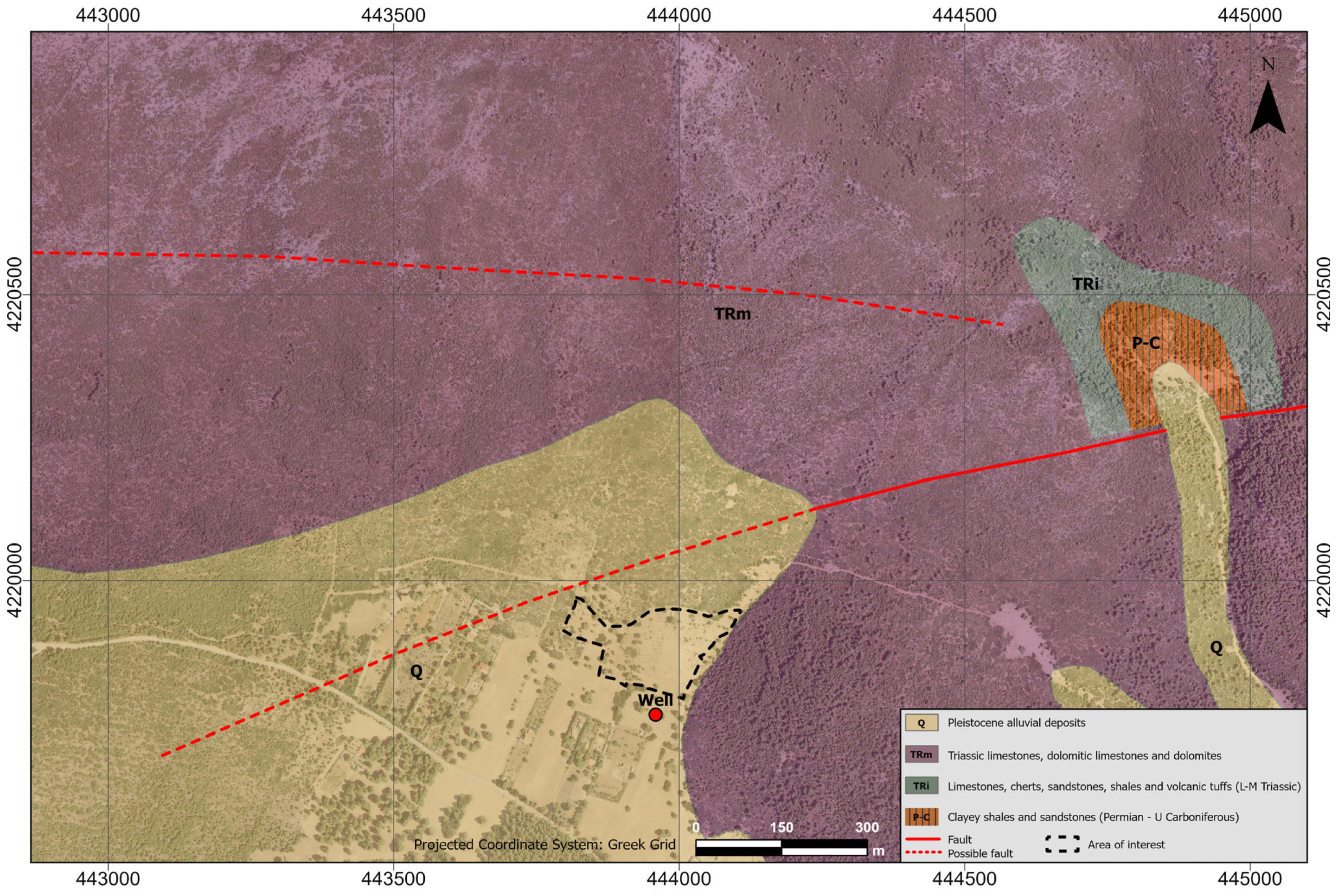

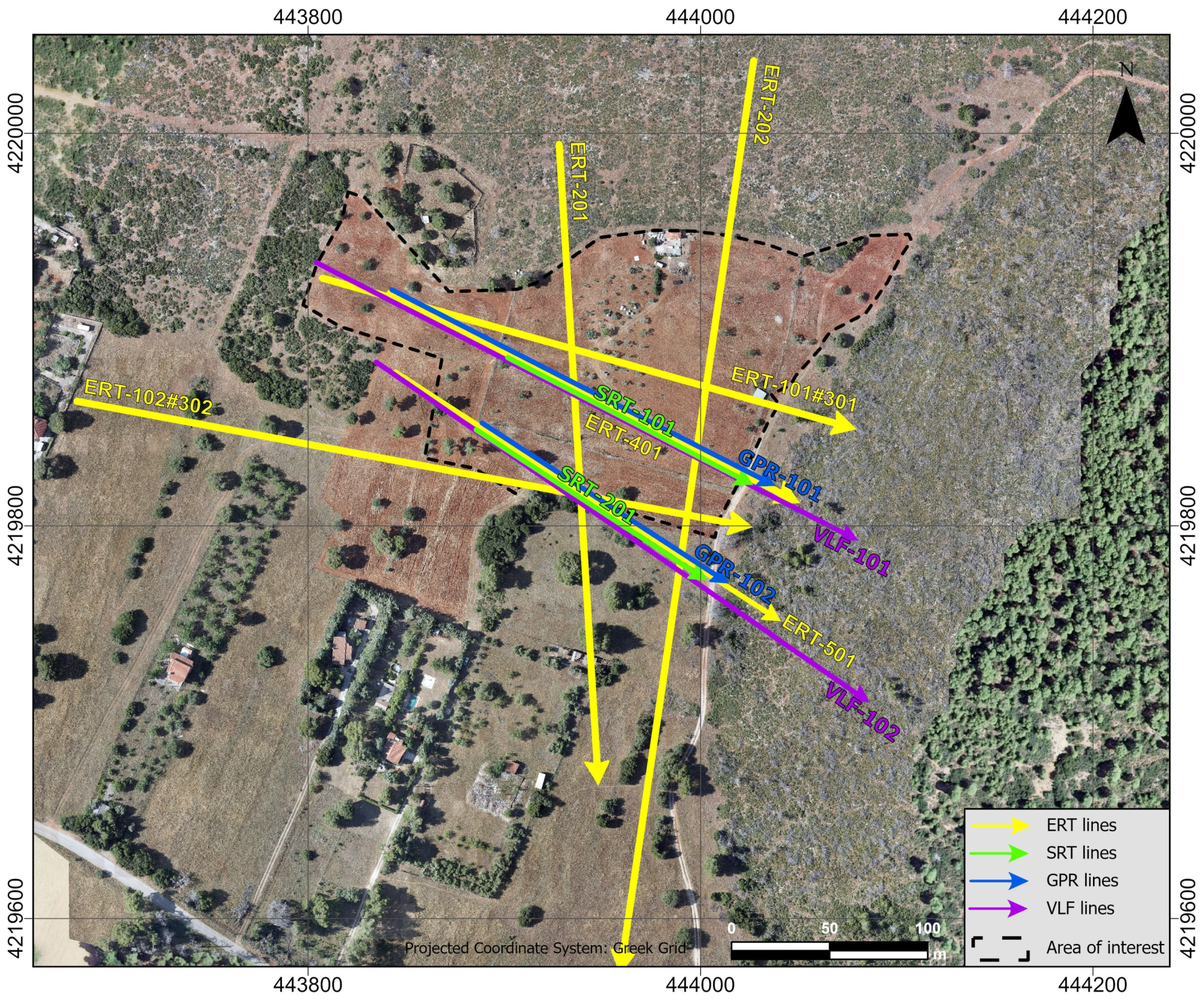
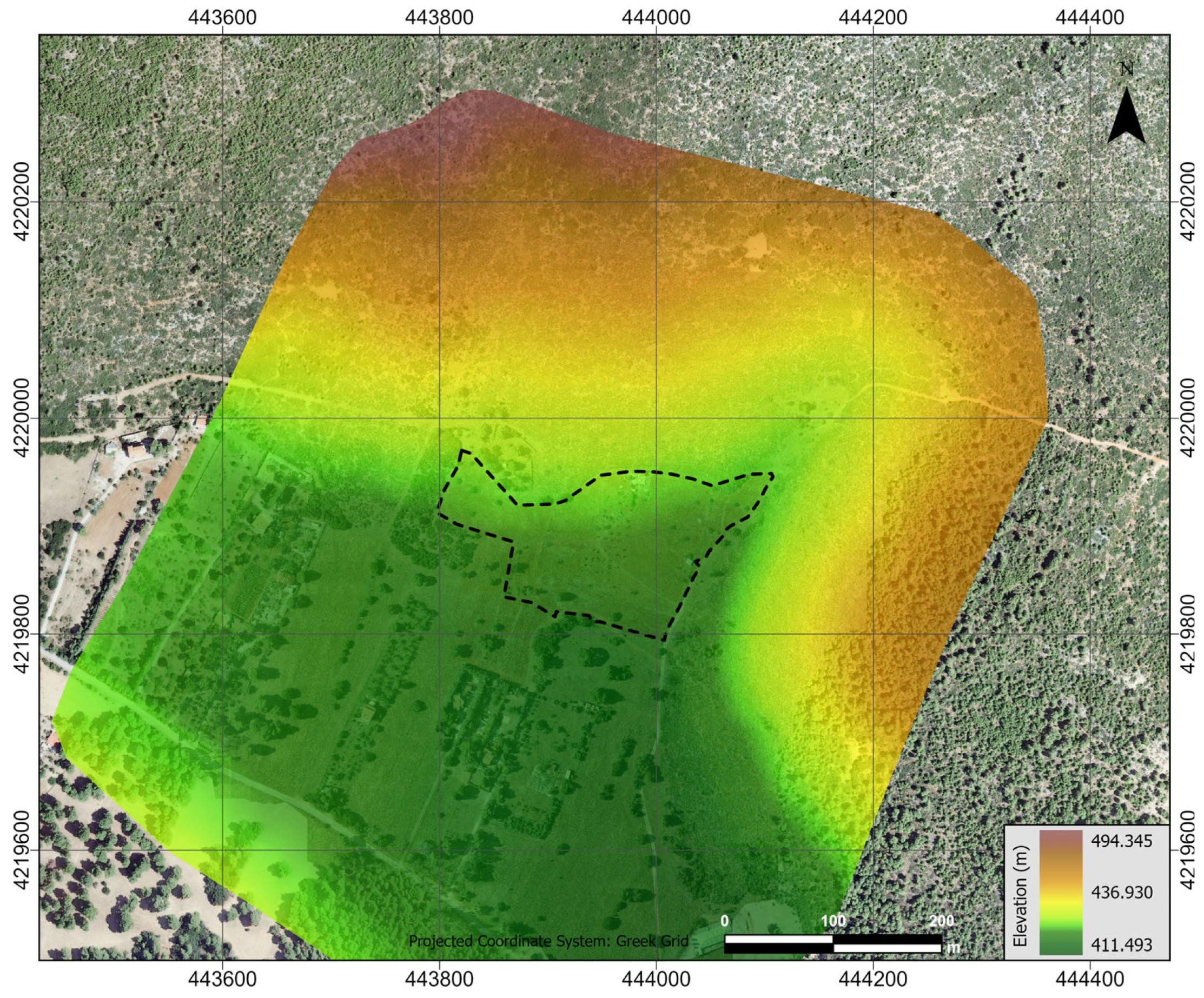



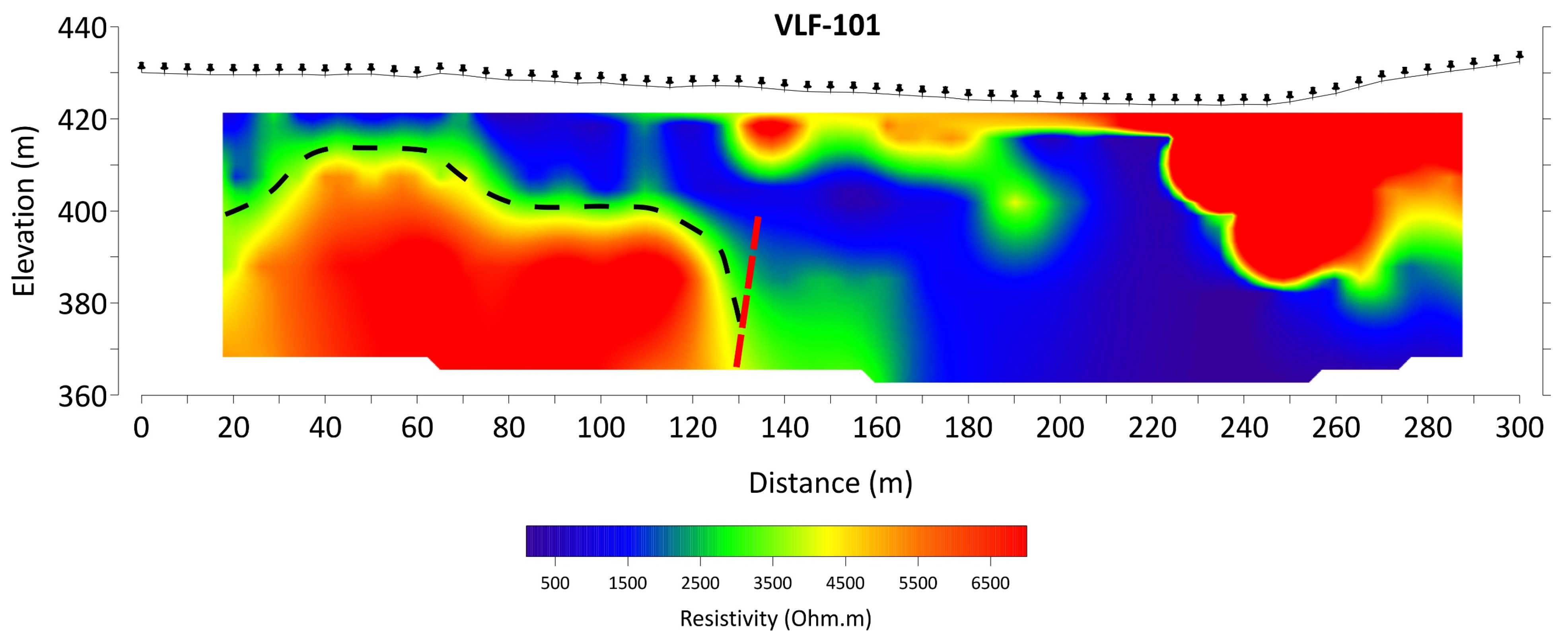

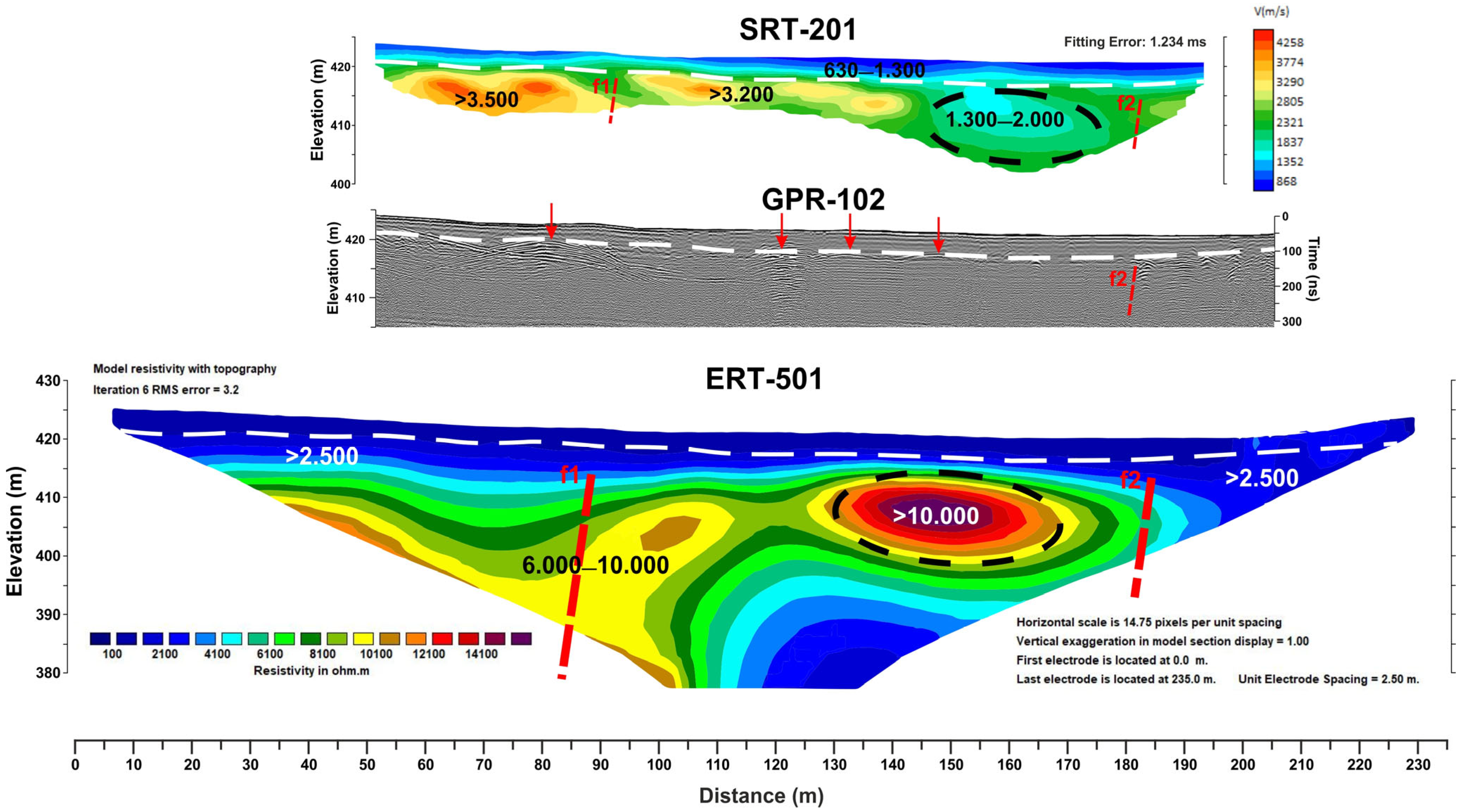
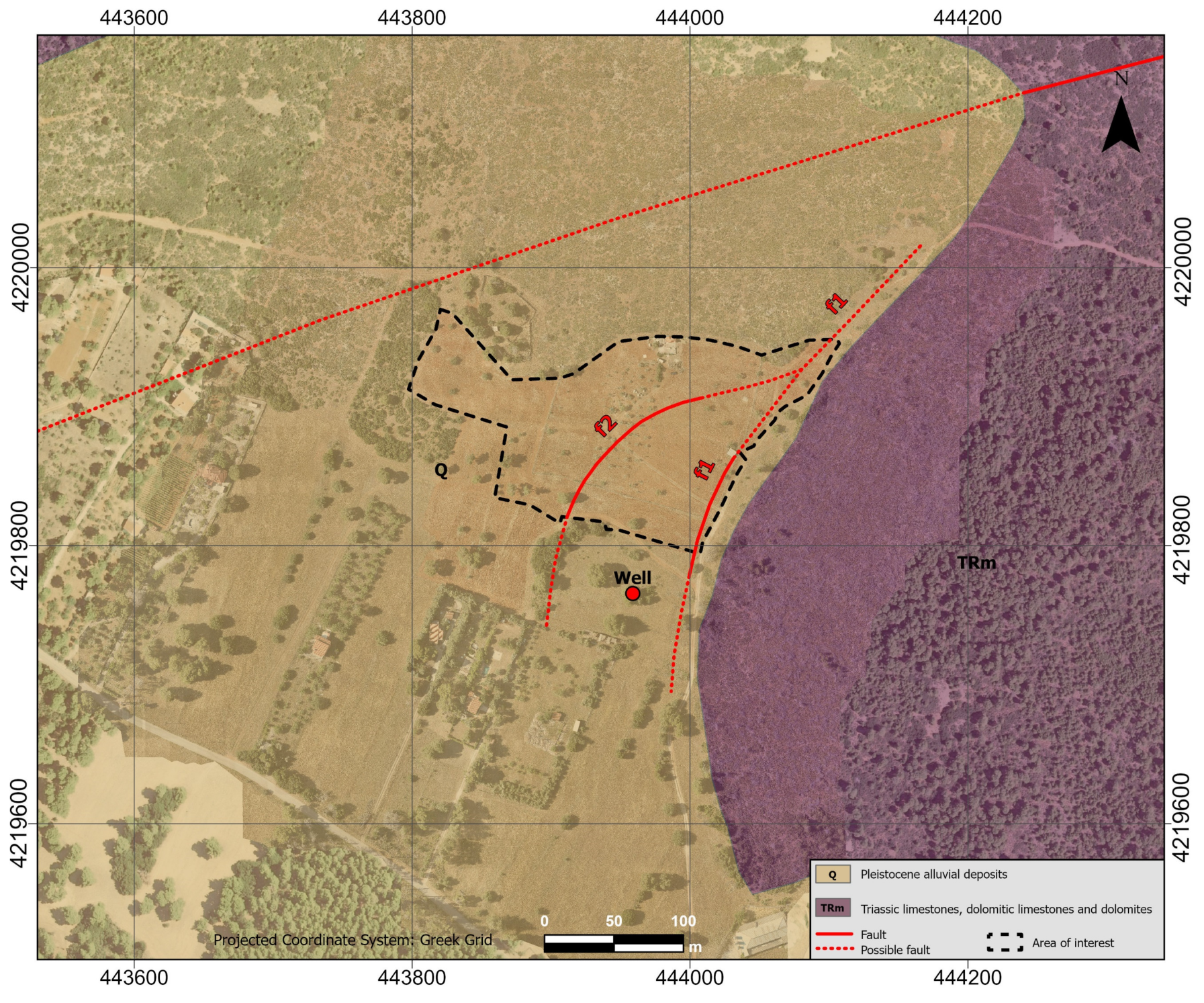
| Code Name | Receiver Spacing/ Step Size (m) | Total Length (m) |
|---|---|---|
| ERT-101 | 6.00 | 282 |
| ERT-102 | 8.00 | 376 |
| ERT-201 | 7.00 | 329 |
| ERT-202 | 10.00 | 470 |
| ERT-301 | 3.00 | 285 (2 roll-along) |
| ERT-302 | 4.00 | 284 (1 roll-along) |
| ERT-401 | 5.00 | 235 |
| ERT-501 | 5.00 | 235 |
| SRT-101 | 3.00 | 141 |
| SRT-102 | 3.00 | 141 |
| GPR-101 | 0.05 | 222 |
| GPR-102 | 0.05 | 155 |
| VLF-101 | 5.00 | 300 |
| VLF-102 | 5.00 | 300 |
Disclaimer/Publisher’s Note: The statements, opinions and data contained in all publications are solely those of the individual author(s) and contributor(s) and not of MDPI and/or the editor(s). MDPI and/or the editor(s) disclaim responsibility for any injury to people or property resulting from any ideas, methods, instructions or products referred to in the content. |
© 2025 by the authors. Licensee MDPI, Basel, Switzerland. This article is an open access article distributed under the terms and conditions of the Creative Commons Attribution (CC BY) license (https://creativecommons.org/licenses/by/4.0/).
Share and Cite
Alexopoulos, J.D.; Gkosios, V.; Giannopoulos, I.-K.; Dilalos, S.; Eleftheriou, A.; Malamis, S. Integrated Geophysical Techniques to Investigate Water Resources in Self-Sustained Carbon-Farming Agroforestry. Geosciences 2025, 15, 317. https://doi.org/10.3390/geosciences15080317
Alexopoulos JD, Gkosios V, Giannopoulos I-K, Dilalos S, Eleftheriou A, Malamis S. Integrated Geophysical Techniques to Investigate Water Resources in Self-Sustained Carbon-Farming Agroforestry. Geosciences. 2025; 15(8):317. https://doi.org/10.3390/geosciences15080317
Chicago/Turabian StyleAlexopoulos, John D., Vasileios Gkosios, Ioannis-Konstantinos Giannopoulos, Spyridon Dilalos, Antonios Eleftheriou, and Simos Malamis. 2025. "Integrated Geophysical Techniques to Investigate Water Resources in Self-Sustained Carbon-Farming Agroforestry" Geosciences 15, no. 8: 317. https://doi.org/10.3390/geosciences15080317
APA StyleAlexopoulos, J. D., Gkosios, V., Giannopoulos, I.-K., Dilalos, S., Eleftheriou, A., & Malamis, S. (2025). Integrated Geophysical Techniques to Investigate Water Resources in Self-Sustained Carbon-Farming Agroforestry. Geosciences, 15(8), 317. https://doi.org/10.3390/geosciences15080317









